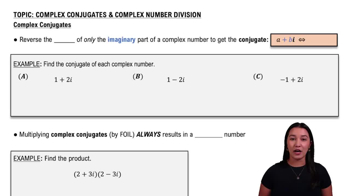Here are the essential concepts you must grasp in order to answer the question correctly.
Rationalization
Rationalization is a mathematical technique used to eliminate radicals or irrational numbers from the denominator or numerator of a fraction. This is typically achieved by multiplying both the numerator and the denominator by a conjugate, which is a binomial formed by changing the sign between two terms. This process simplifies the expression and makes it easier to work with, especially in calculus and algebra.
Recommended video:
Rationalizing Denominators
Conjugates
Conjugates are pairs of binomials that have the same terms but opposite signs between them. For example, the conjugate of 'a + b' is 'a - b'. When multiplying a binomial by its conjugate, the result is a difference of squares, which eliminates the square root or irrational part, simplifying the expression. Understanding conjugates is essential for effective rationalization in algebraic expressions.
Recommended video:
Simplifying Radicals
Simplifying radicals involves reducing a radical expression to its simplest form, which often includes factoring out perfect squares or other factors. This process is crucial when rationalizing expressions, as it helps to clarify the final result. For example, in the expression 2√10 + √7, recognizing that √10 and √7 cannot be simplified further is important for correctly applying rationalization techniques.
Recommended video:
Simplifying Trig Expressions
 Verified step by step guidance
Verified step by step guidance Verified video answer for a similar problem:
Verified video answer for a similar problem:



 2:9m
2:9m